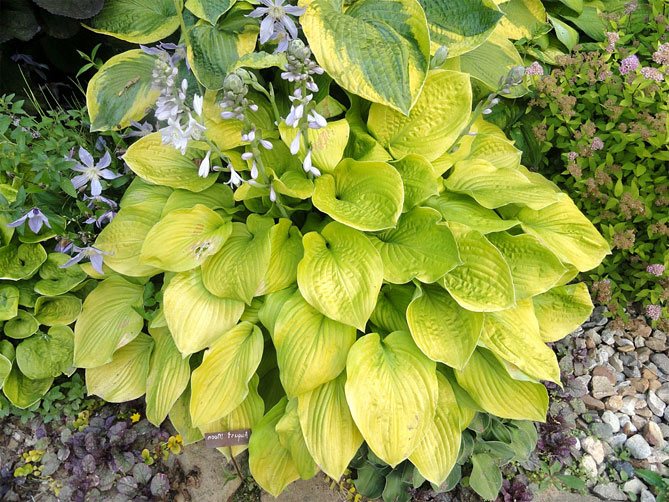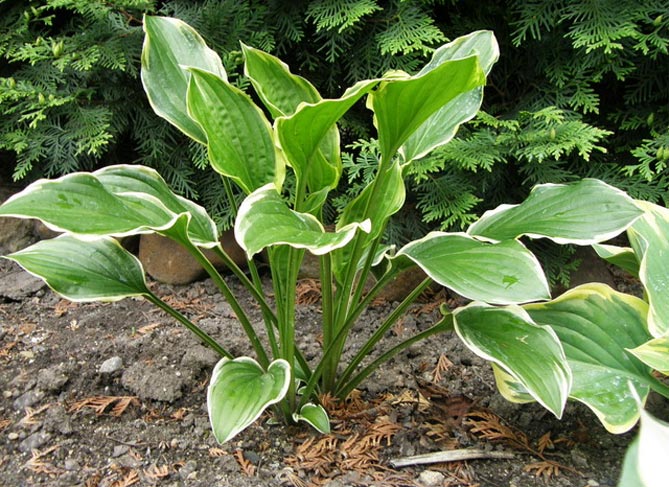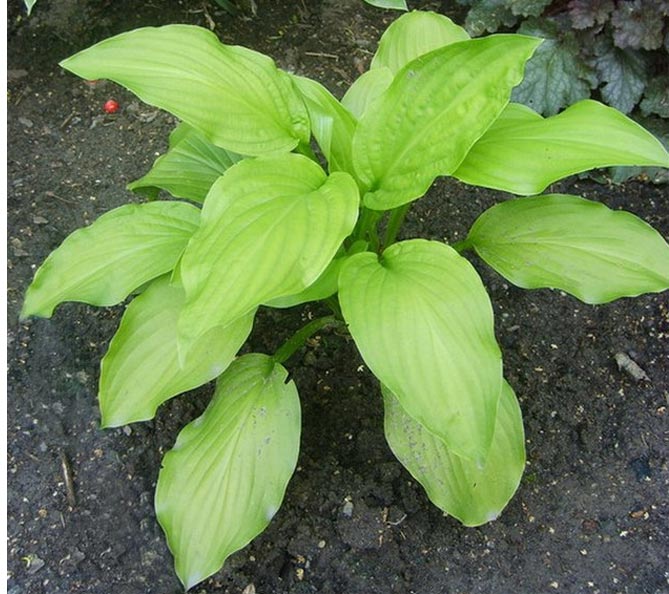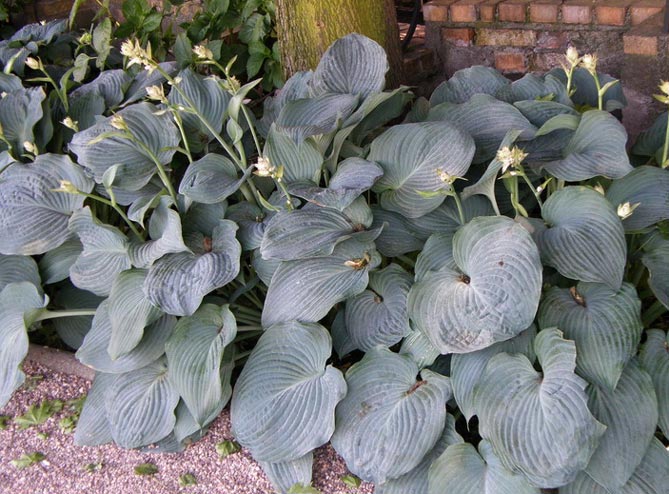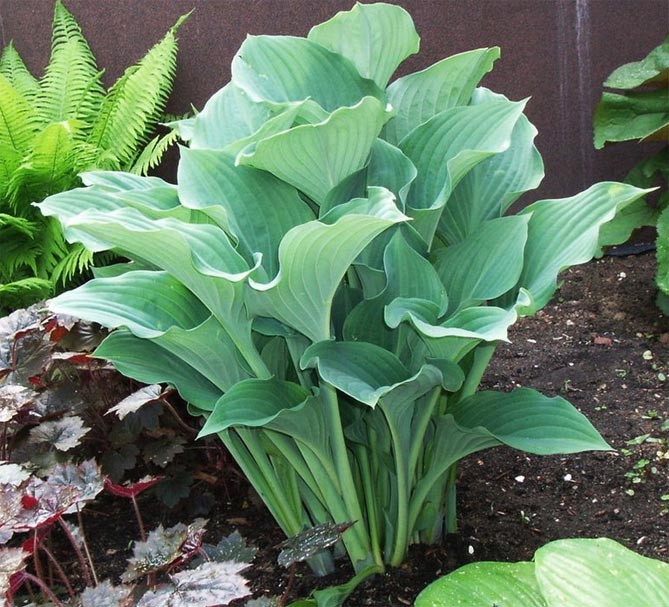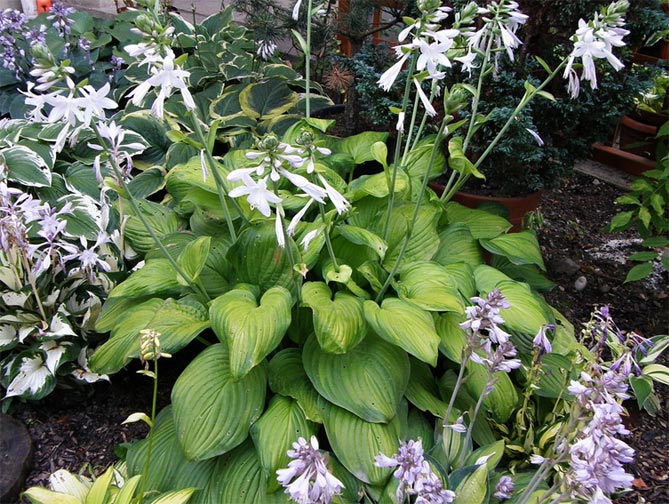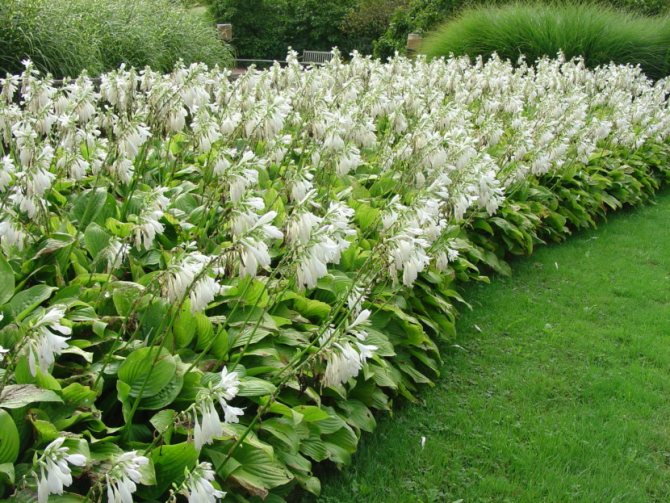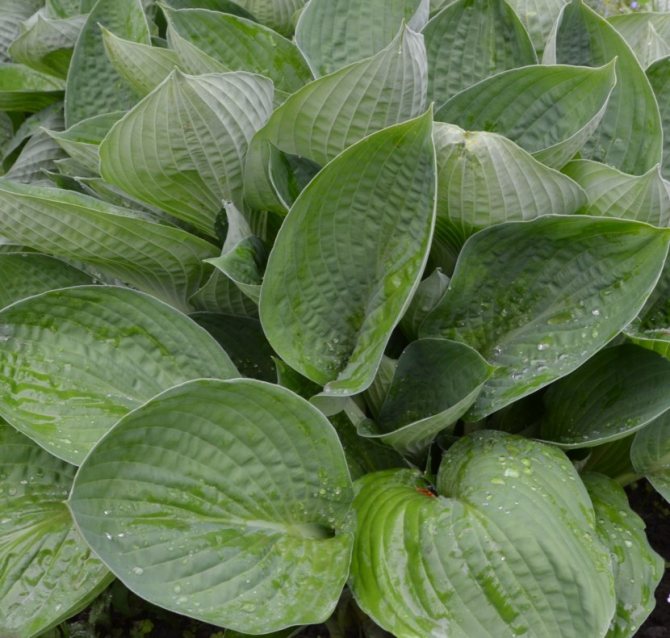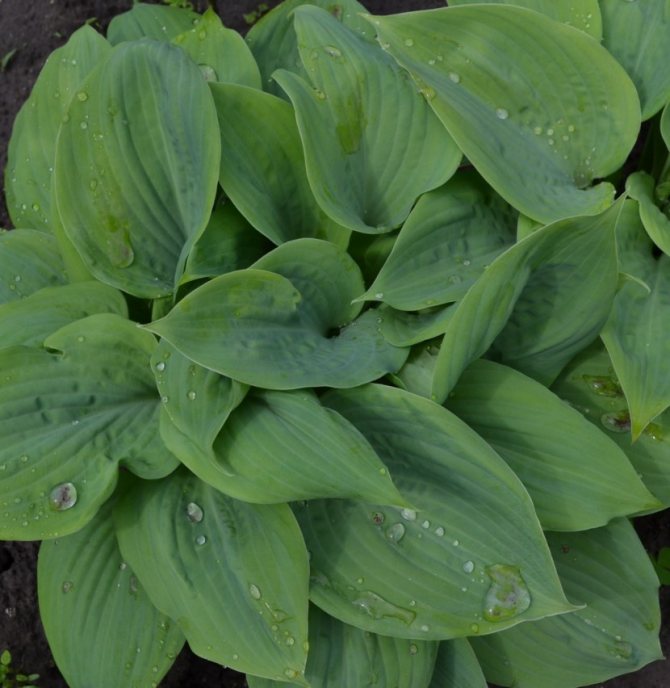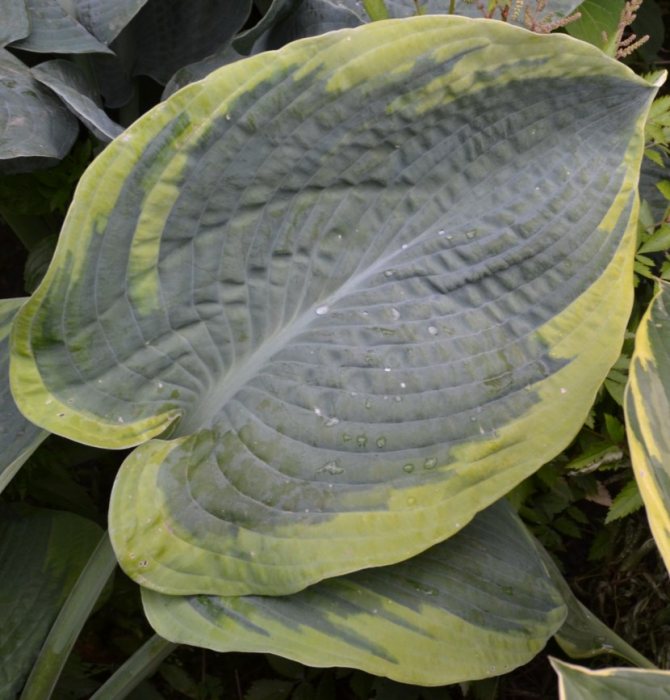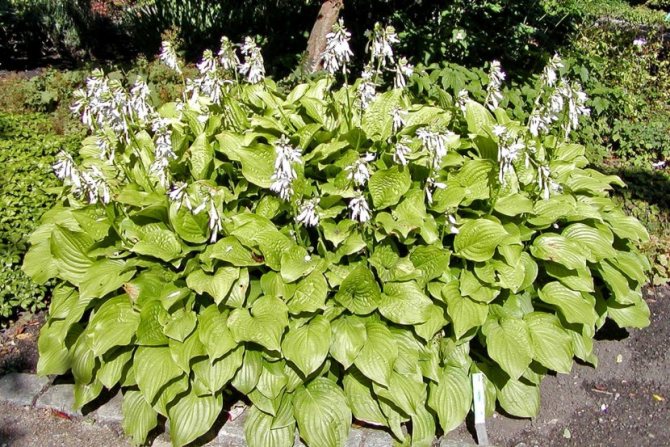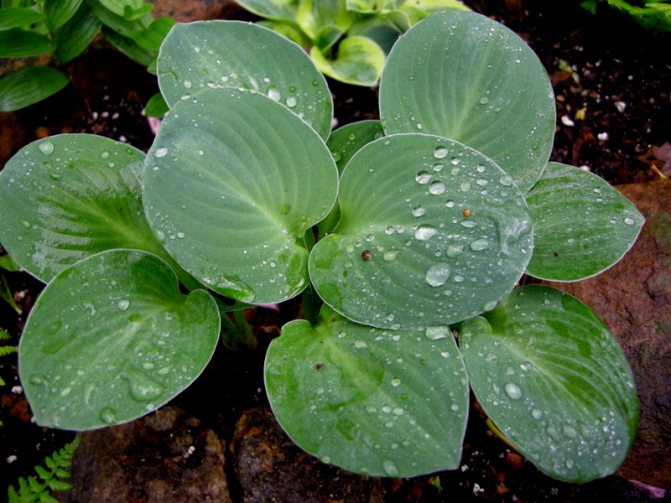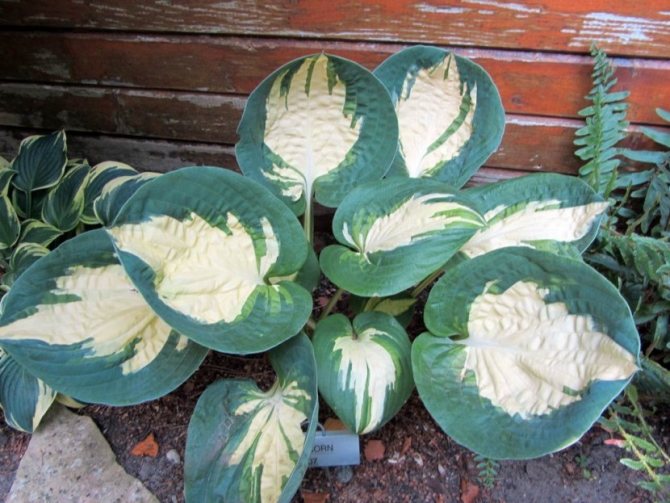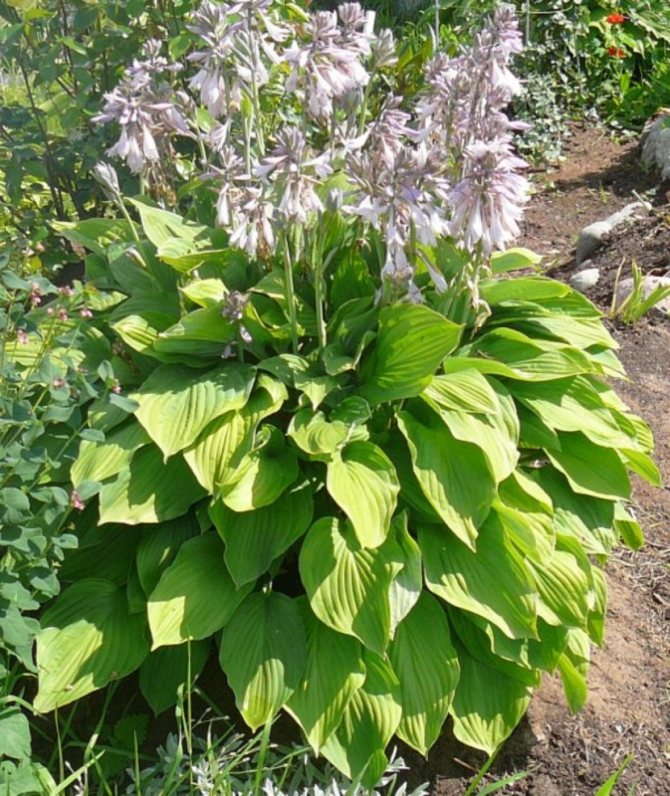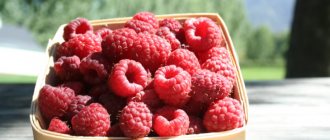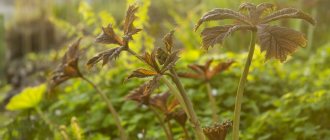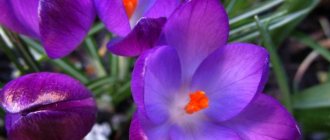The many-sided hosta, planting and care in the open field, which is within the power of any amateur gardener, is an extremely prominent representative of landscape and park design.
These perennials have a wide variety of shapes and colors, allowing them to find a suitable place in almost every composition.
The varied and luxurious hosts in the garden always look great.

Description of the plant
The hosts are very diverse - from giants that form sprawling plants over 1 meter in height to dwarf bushes that do not exceed 10 cm in height, ideal for containers or plantings in groups. Thanks to this variety, the hosta flower can decorate gardens of various designs.
This perennial plant native to the Far East (China and Japan) was very popular in the gardens of England in the 19th century. Now it is experiencing its renaissance, there are a huge number of new varieties on the market.
Hosta is a perennial with a wide range of uses. It is prized primarily as a plant that prefers shade, but some varieties can grow in partial shade and even in places with fairly strong sun exposure.


Leaves
Host leaves vary in size, shape, and an unusual variety of colors.
The shape of the leaves is:
- lanceolate,
- ovoid,
- oval,
- heart-shaped,
- round.
Leaf colors: green in various shades, yellow, bluish, green-blue, white, gold. These colors appear uniform or in various combinations of shades, with dark or light edges on the leaves, stripes, spots of varying intensities and patterns. An additional advantage of these plants is the variability of flowers and leaves during the season.
It is difficult to describe the colors, their different shades, the width and shape of the leaves, so it is better to look at the photos to imagine the variety and charm of the hosta.


Flowers
Hosts are grown mainly for the beautiful leaves. Their flowers are hardly noticeable and are often overshadowed by decorative leaves. Only the flowers of some varieties deserve attention.
Usually in the descriptions of the variety there is information: lavender flowers, light lavender, almost white. Sometimes the flowers, in addition to the main color, have an interesting coloration in a color other than the whole flower. Interesting flower shapes stand out, many of them have a very pleasant and intense aroma.
Plant size
Depending on the size, hosts are divided into 6 groups:
| Name | Hosta height, cm | |
| 1 | Miniature | 7,5-15 |
| 2 | Small | 15-30 |
| 3 | The average size | 30-60 |
| 4 | Large | 60-90 |
| 5 | Very big | 75-90 |
| 6 | Super big | more than 90 |
The smallest bushes have a diameter of about ten centimeters.
One of the largest hosts is the Empress Wu variety. Its height is 1.5 meters, the size of the sheet reaches 45-60 centimeters. The sight of such a giant is impressive.
Photo. Hosta Empress Wu
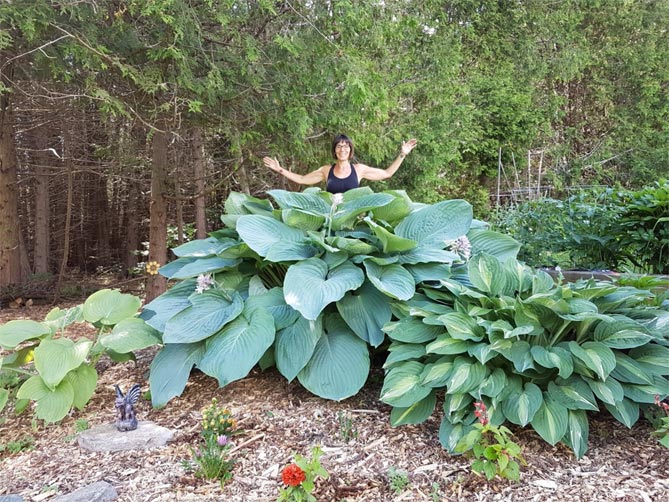

How to contrast compositions and shapes
To create a bright contrasting flower garden, the elements of which, harmoniously complementing each other, form an integral picturesque picture, a number of points should be taken into account.
Lush host bushes with leaves of a uniform color in landscape design play more of a background role. They go well with garden plants: astilbe, peonies, bleeding centers, ferns.
In appearance, the flowers of the dicentra resemble small hearts.Caring for these plants comes down to several rules:
The decorative role of a single planting is more assigned to large varieties and specimens with two or three-colored leaves. Such variegated bushes outwardly resemble large flowerpots placed in the corners of the garden, filled with huge bouquets.


Plants with small foliage will become successful partners for the host: purple periwinkle, subulate phlox, blue forget-me-nots, poppy and rhododendron
Decorative varieties of conifers help to effectively emphasize the spreading and beauty of the hosts.
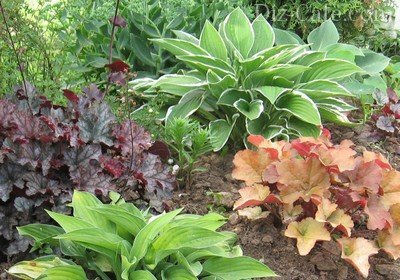

Vivid contrasts of the composition can be obtained by planting grassy plants with a different shade of leaves not far from the host, for example: Heuchera with purple foliage or Horny Goat weed with burgundy leaves
The material on planting and caring for Heuchers may also be useful:
The vertical accent of the plant composition is given by phlox, kupen and daylilies. Cereals such as miscanthus and reed grass help to complete the composition.
Some interesting facts about the host
- Hosts can grow in one place for 100 years, but reach maturity at the age of 6-9 years, depending on the variety.
- Young plants often do not look like adults (they have different colors, shapes, leaf textures). This is especially true for blue varieties. Young seedlings of blue varieties are mostly green or slightly green-blue.
- Many cultivars with green leaves with a yellow center or yellow leaves with a green edge (eg Gold Standard, Paradigm, Color Glory) are completely green in early spring, yellow appears when exposed to light ... Before you start worrying that you have purchased the wrong variety, you should wait a bit.
- There are no varieties with blue or blue leaves. All leaves are green-blue (much depends on the fertilizer). The blue color of the plant is due to the wax covering the leaf blade. A special 5-point scale is used for the assessment. For example, Halcyon is considered blue and has a level 2. Blue is most intense in spring.
- Hosta varieties with white leaves retain their color only in early spring and turn green relatively quickly. Higher temperatures and sunshine speed up the greening process, so these varieties require a cool, shady location.
- Hosta plant sizes given in the variety descriptions are approximate. The final height is influenced by many factors: microclimate, soil, irrigation, fertilization.
- Most varieties change color during the season.
- In autumn, the leaves of the hosta turn yellow and die off, this happens at different times depending on the variety. The process starts in September and continues in October.
- The hosts do not occupy the territory, but every year they form large clusters, with a large number of shoots, up to the sizes indicated in the descriptions of the varieties.
- Hosts require little maintenance.
Dwarf hosts and their use in landscape design
Dwarf hosta varieties are the best suited for alpine slides. Such solutions require careful design. In this case, it is the height of the plant that plays an important role.
Small hosts look very neat, they can be planted along the entire length of an alpine slide or in certain parts of the composition. In addition, they are combined with different types of moss, succulent plants, dwarf flowers.
Photos of dwarf hosts:
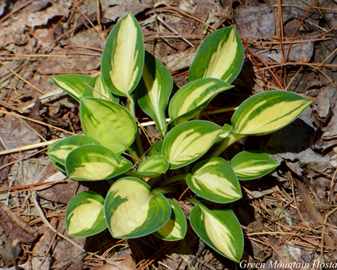

Some varieties - photo
Hosta varieties differ in shape, size, and color of leaves. Thanks to the multi-colored varieties with bright or variegated leaves, you can decorate any shady corner of the garden.
| Name and description of the variety | Photo |
| "Blue Angel" Blue Angel. Height / width - 100/180 cm. Leaf (length / width) 46/31 cm. The color of the leaves is blue-green. Flowers are light lavender, almost white, blooms in July. The recommended position is 50-90% of the shade. One of the largest blue-green hosta varieties. In spring, it emerges from the ground relatively late, it is not threatened with late frosts. |
|
| White Bikini White Bikini. White host. Height / width - 70/110 cm.Leaf length / width - 23/14 cm. Color - dark green leaf with a white belt in the center. Flowers are lavender. Blooms from mid-July to mid-August. Position - shadow, partial shade. |
|
The following grades are recommended for sunny positions
| Variety name | Photo |
| With yellow leaves | |
| August Moon |
|
| Gold Regal |
|
| Sun Power | |
| Multicolored | |
| Gold Standard | |
| September Sun |
|
| So Sweet |
|
| With green leaves | |
| Invincible |
|
| Honeybells |
|
| Lancifolia |
|
| With blue leaves | |
| Blue Angel |
|
| Elegans |
|
| Krossa Regal |
|
| With fragrant flowers | |
| Fragrant Bouquet |
|
| Guacamole |
|
| Honeybells |
|
| Summer Fragrance |
|
| Royal Standard |
|
For decorating lawns and just in pots
The design of lawns is no less varied. Single plantings of the host on the lawn (for example, in the center) are possible, if you want to arrange the lawn around the perimeter - then you can plant bushes in the shape of a square - this combination will emphasize the integrity of the lines.
You will be interested in: Perennial bulbous garden flowers: description with names and photos
When choosing a funkia as the central element of a garden plot, you can emphasize its beauty by sprinkling gravel and tree bark around it.
Hosta bushes in a pot also look unusual - in the form of flowerpots. For this, it is better to choose sufficiently deep and wide pots.
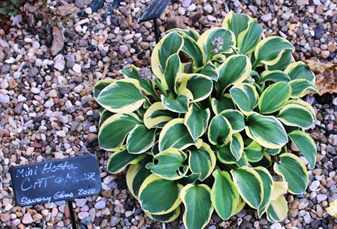

Care and cultivation
The main decoration of the hosta is the leaves. During the season, the leaf goes through the stages of youth, maturity, aging and withering away. The most important is the period of maturity, when the plant is most beautiful. In order for the maturity period to be as long as possible, several conditions must be met:
- choose the right position for the variety;
- make proper preparation of the substrate;
- watering correctly;
- apply suitable fertilizer;
- properly mulch the soil;
- carry out suitable grooming procedures.
Choosing a position in the garden
Positioning is a key element of success in growing hosts. The sun provides the correct color, but accelerates aging or completely destroys the leaves, so the most suitable position is shade and partial shade:
- shadow - a place to which the sun has access 3 hours a day;
- partial shade - receives sun rays for 3-6 hours.
Shadow
Some host species, such as Color Glory, George Smith, should not have direct access to sunlight and should be shaded. A position behind a high wall or among trees with high crowns, but not too dense, is best suited. A position where there is a dense dark shadow with an absolute lack of light is not suitable for hosts.
Partial shadow
The most optimal position is where the morning sun reigns, when the air is not yet very hot and has a lesser effect on the aging of the leaves. The midday sun is more harmful for the hosts, but in this position the plant grows well.
Sunny position
The sunny position is a place where direct sunlight falls for at least 6 hours, of which at least 4 hours fall on daytime hours.
A place where the sun has constant access to the plant during the day is practically not suitable for growing hosts. This position works well in spring and early summer, but later the leaves age quickly from strong sun. There are options for how to withstand excessive sun exposure, but this applies more to positions with morning and afternoon sun.
In fact, none of the hosta varieties should be grown in full sun. Some varieties can tolerate quite a lot of sun exposure. Such plants require careful maintenance, a constantly moist substrate is needed so that they can replenish their water reserves due to strong evaporation through heated large leaf surfaces.
Attention! Try to avoid growing your hosts near white walls or other coatings that additionally reflect the sun's rays, which dry out the leaves. This is especially true in a sunny place.
For hosta growing in the sun, you need to specially prepare the soil:
- the soil should contain more moisture-retaining ingredients (peat, compost);
- it is necessary to mulch the soil to protect it from excessive heating, rapid evaporation of water.
Having decided to grow a hosta in a sunny flower bed, you need to take into account that the color of the leaves will be completely different than in more favorable conditions:
- yellow hosts can acquire an almost white leaf color;
- blue varieties acquire leaf colors similar to green.
Photo. Hosta variety "Gold Standard" (Gold Standard), grown in partial shade (pictured on the left), in the sun (right).
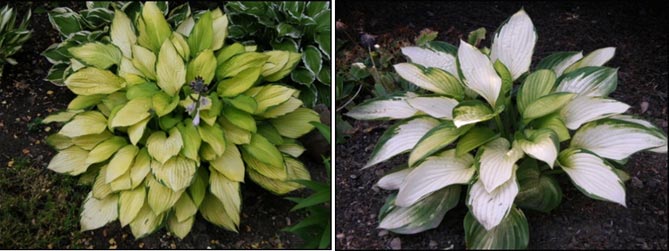

It is generally not recommended to plant the hosta in sunny conditions, but according to various sources, below is a list of varieties that are more resistant and capable of growing in high solar conditions.
Hosts with yellow leaves:
- August Moon,
- Gold Regal,
- Sum and Substance,
- Sun Power.
Multicolored hosts:
- "Gold Standard",
- Inniswood,
- Regal Splendor,
- Sundance,
- September Sun
- So Sweet,
- "Francie" (Francee),
- Patriot
- Minuteman.
With green leaves:
- Invincible,
- Pearl Lake,
- Royal Standard,
- Honeybells
- "Lancifolia" (lancifolia).
Hosts with blue leaves that can withstand strong sunlight (but not recommended for areas with extended exposure to midday sun):
- Blue Angel,
- Elegans,
- Halcyon
- Krossa Regal.
Fragrant flower hosts require more light. Growing in shady places, they bloom less abundantly, and flowers and leaves are less:
- "Aphrodite"
- Fragrant Bouquet,
- «Fred Green Tomatoes "(Fried Green Tomatoes),
- Guacamole,
- Honeybells
- Invincible,
- Royal Standard,
- Summer Fragrance.
Through trial and error, you can determine which varieties can grow in bright sunlight. It is necessary to monitor the host, and replant if signs of excessive sun exposure are found:
- darkening of leaves at the edges or tips,
- matting colors,
- faded spots.
Advice! In the presence of these symptoms, one should not hesitate to transplant hosts, the plants have a strong root system and can easily tolerate transplanting at any time of the year, and growing in the wrong position will cause them more harm.
How to choose a seat?
- Green and blue varieties grow better in shade, partial shade.
- The yellow varieties do well with a lot of morning and midday sun.
- Multicolored varieties grow best in partial shade.
- Chlorophyll-free varieties (Color Glory, George Smith, Supernova, Dance with Me, Tokudama Aureonebulosa) require a position without access to the sun.
Soil selection
The substrate is an important factor in the size of the hosts.
Best soil for hosts:
- fertile,
- slightly acidic,
- pH 6,
- permeable, providing the roots with air and maintaining sufficient moisture.
It is recommended to prepare the soil from the following ingredients in appropriate proportions:
- 1/3 of your own land from the garden;
- 1/3 de-acidified peat;
- 1/3 of the crushed compost bark (if you use cheap uncomposted bark, in the first year you need to increase the amount of nitrogen in the fertilizer, because when the bark decomposes, soil microorganisms use nitrogen, taking it from the plant).
Advice. A good addition to improve air access to the roots is expanded clay, readily available in building supermarkets and cheap if bought in bulk.
Landing
If the seedlings are purchased in advance, it is important to know how to store the host before planting. It is best to store the seedlings sprinkled with wet sand or peat in a box or box. The box is placed on a cool balcony or basement. At home, the seedling can be planted in a pot. Rhizomes can be stored simply in the refrigerator, sprinkled with peat or wrapped in damp newspaper, cutting the roots to 10-15 cm.
In open ground, seedlings are planted in mid or late May, when the last frosts have passed.
Hosta boarding is done on cold days. The plant is positioned so that the rhizome is about 4-5 cm below ground level. There is enough space between the plants - usually 0.5 meters, the distance depends on the characteristics and requirements of the variety.
Watering
For the leaves of the hosta to be beautiful, large, strong and full of energy, they need moisture (but not flooding!). Drip irrigation is the best solution.If this is not possible, you need to water the plant so that water does not fall on the leaves. This will prevent the wax from washing away from their surface, which is very important, especially in the case of blue varieties, where the wax covering the leaves determines their color. Gentle watering limits the risk of developing fungal diseases and burning leaves in the sun.
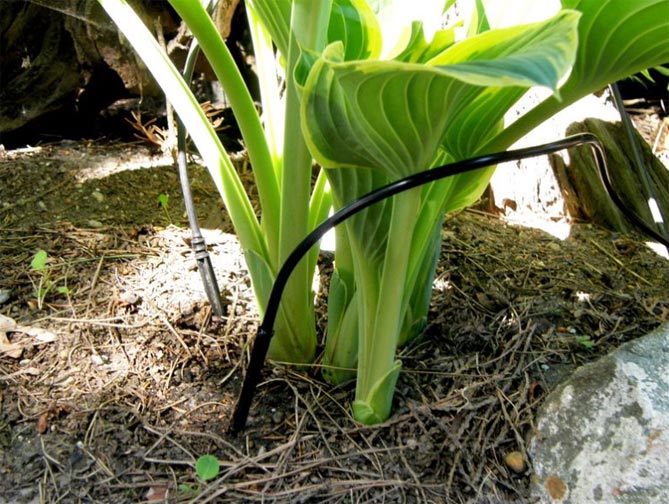

Fertilizer
This factor has a significant effect on the color of the leaves, their mass, elasticity. Hosts do not require intensive fertilization. Top dressing is done several times a season or long-acting fertilizers are used. The main components of fertilizers are nitrogen (N), phosphorus (P), potassium (K). The proportions of these ingredients determine the suitability of the fertilizer for our plants.
More nitrogen will brighten and wash out the colors, so fertilization can be divided into 2 steps:
- In early spring: fertilizer with a lot of nitrogen is applied before the leaves appear. It is necessary to obtain a developed leaf mass. Therefore, formulations with NPK proportions are chosen - 20:10:10. Of the popular fertilizers, azofoska is suitable. It should be remembered that when using mineral formulations there is a risk of over-feeding. According to gardeners, it is better for large hosts to apply a handful of fertilizers per plant, for small ones - accordingly less, a small spoon is enough for miniature bushes.
- Spring - summer: hosts color better when formulations with a balanced nutritional content are used. That is 10:10:10 or 20:20:20. During this period, it is most convenient to use fertilizers with a prolonged effect, such as Osmokot, with the NPK proportions given above. In addition, it is useful to fertilize plants with foliar formulations 2-3 times. Formulations with added micronutrients in the form of easily digestible chelates are best suited. Foliar fertilizers with a predominance of nitrogen are suitable for hosts of yellow, green flowers. However, care should be taken when using these formulations for blue plants. They make the blue plant turn green. For the blue varieties, a balanced NPK fertilizer is used.
Organic fertilizers
Organic matter (manure, compost) is a rich source of nutrients (macro- and microelements). It is also safe for hosts. But these fertilizers are difficult to apply to maintain adequate NPK ratios and will have to deal with other than expected leaf coloration.
To prepare the host for winter, fertilization is completely stopped at the end of August.
Mulching
Mulching significantly improves the moisture and air conditions for the hosta roots, prevents drying out and hardening of the topsoil.
Mulch options:
- Shredded bark is the most popular mulch material.
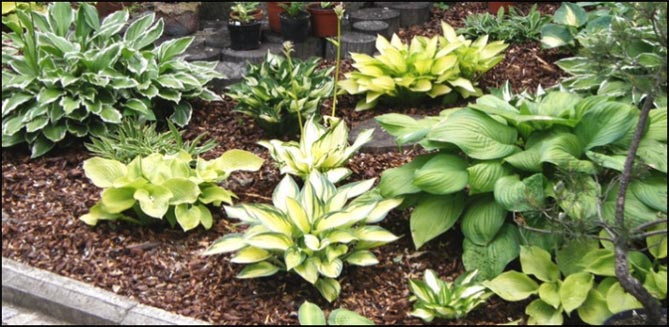

- Agrotextile. Florists additionally use agrotextiles under the bark, which can significantly reduce the number of weeds. This is especially useful when the seedlings are small and there is a lot of empty space between individual plants. Nowadays, brown agrotextiles can be purchased without any problems, which are much less noticeable as bedding than black ones.
- Cones, needles. When grown among conifers, this natural and cheap material complements the garden design.


Attention! Mulching also has disadvantages. It becomes a hiding place for snails and other pests that like to eat beautiful leaves.
Pruning
Hosta care is simple and limited to the removal of damaged, yellowed, fungal leaves or shoots, faded inflorescences. However, these activities have become a source of serious danger to the hosts. Hosta Virus X, popularly called HVX, appeared a few years ago.
What plants to plant hosta with
Harmonious plantings are built on the contrast of foliage. Selecting the participants in the compositions, it is necessary that the living conditions coincide. I will name the shade-tolerant plants with which the hosta is well adjacent:
- marsh iris;
- daylilies;
- buzulnik;
- garden fern;
- lungwort;
- undergrowth;
- geychera;
- forget-me-not;
- astilba;
- kobei, etc.


One-sided flower garden with hosts and daylilies
Unwanted pairs with crops that have an aggressive root system, ground cover and light-requiring:
- badan;
- Turkish carnation;
- lavender;
- phlox;
- liana-like;
- primroses;
- periwinkle;
Consider the size of the plants in the combinations. The host grows quickly, plant small perennials remotely.
Diseases and pests
Host Virus (Hosta Virus X)
The virus is spread by mixing the juice of an infected plant with the juice of a healthy plant. This often happens during the nursing process or when transplanting plants.
There are many outdoor cultivars available on the market. New plants in the garden can become a source of infection. The incubation period of the disease takes up to several years, depending on the variety. Therefore, a seemingly healthy plant can unexpectedly become a source of the virus.
What you need to know:
- any plant from an undetermined source can be a carrier of the virus;
- if there is no confidence in the plants, care must be taken when leaving;
- It is recommended to use gloves and disposable plastic knives for each host.
How to recognize a host virus and what to do with an infected plant?
Most often, the virus is seen on the Gold Standard, Striptease, Sum and Substance varieties. But the list of vulnerable co-workers is constantly growing. The disease does not kill the plants. The main threat is the rapid spread of the virus. Because symptoms may appear several years later, HVX has infected hundreds or thousands of plants around the world. If a batch of seedlings shows signs of a virus infection, it must be destroyed.
You should not buy hosts from a batch that has the slightest symptoms on at least one plant. Infection can occur every time a bush is trimmed and gloves or tools are not disinfected.
Infected plants must be carefully dug up with a lot of roots and destroyed. Hostas should not be planted in this place until the remnants of the roots rot.
Types of symptoms caused by HVX
The pictures below show the symptoms of the host virus.


- Infiltrates, discoloration (spots that look like blots on paper) are usually the first symptoms you notice. These are early signs of host disease that appear in most plants with HVX. Usually the spot is characterized by a color different from the surrounding tissue and is located symmetrically along the veins. The virus "enters" the leaves through vessels with sap, from where it spreads to the leaf tissue, causing discoloration.
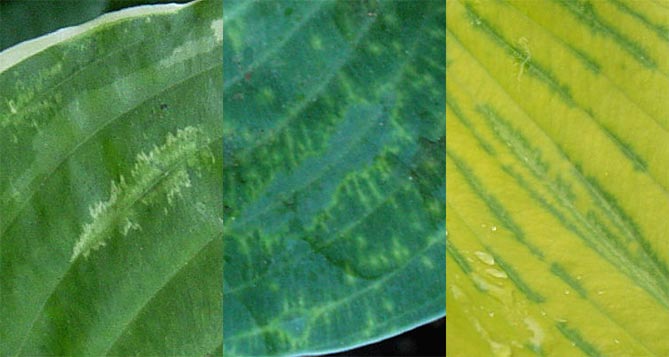

- Depressions, depressions in the tissue are usually a sign of a more severe infection, it looks like the leaf tissue has been destroyed, and all the water has gone from the affected point. Although the word “dehydration” is sometimes used to describe the phenomenon, the tissue is not dry or dead and may remain so for the rest of the season. Sagging can be accompanied by a color change of the hosts.
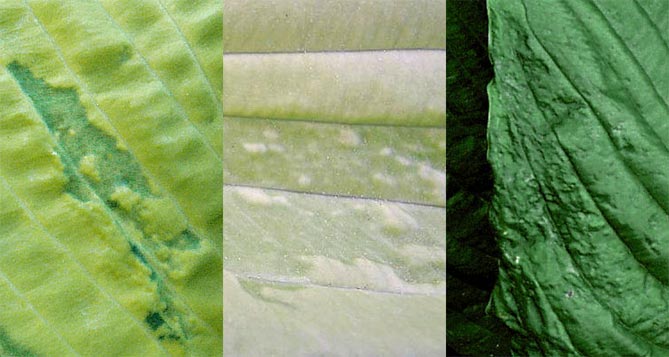

- Spots, specks are the third type of symptoms. They are also caused by other viruses.


Plants with these symptoms should be considered infected with the virus and destroyed so as not to infect healthy neighbors.
It has been proven that there are no varieties that are resistant to this virus.
Are the HVX symptoms appealing?
The impact of HVX on some hosts looks appealing. Spots and other symptoms help the plant to appear denser, more compact, and the leaves sometimes have a prettier hue. Some nursery owners and growers give names to infected hosts and sell them as new varieties.
How fast is HVX spreading?
Dr. Lockhart, who discovered the HVX virus, says the virus is relatively difficult to spread. Compared to other viruses spread by insects and other natural carriers, HVX does not have this ability.Gardeners and nursery owners believe that the virus is spread by pruning, dividing plants.
Can infected plants be cured?
The virus will not go away on its own. It stays on the plant forever. There is currently no cure for the virus.
When multiplying by division, if the mother bush had a virus, it will spread to all plants obtained by this method. Many infested bushes from supermarkets are obtained this way. Plants appear healthy, and the virus shows up with growth after a few years.
Does the virus kill or restrict plant growth?
The virus infects the host, but the infected plant can survive for many years. Viruses affect bushes in different ways, some symptoms go unnoticed. The symptoms of the virus may go away, which does not mean that the plant is cured. The virus remains and is able to infect other hosts. Sometimes environmental factors can limit the growth of the virus population and the intensity of symptoms.
Will removing an infected leaf or infected plant part help?
Removing the infected tissue has no effect. When the virus becomes visible, it is already present, in the entire plant or in most parts of it.
Snails
Hostas have few natural enemies, but snails become a serious problem when growing. Leaves of many varieties are a delicacy for snails and slugs.
Natural barriers are erected from snails:
- mini-fences made of galvanized steel sheet, about 20 cm high or tape (it is important not to hurt yourself about such a fence);
- dry sawdust, planed bark, barley husks;
- the soil near the plant is sprinkled with stone flour or wood ash, but these materials are effective only on dry days;
- sharp gravel, crushed clinker, egg shells, sharp sand, needles of trees, coniferous shrubs, prickly twigs of barberry, holly leaves, broken glass;
- quicklime, kainite, superphosphate, salt - the use of these preparations is effective before precipitation; slugs after contact with drugs begin to secrete a large amount of mucus, dying from dehydration; the use of salt can lead to salinization of the soil;
- methods of processing the site: frequent mowing of lawns, collection of plant residues;
- setting snail traps - grapefruits, cucumbers, cabbage leaves, chopped carrots, apples, potato halves, beetroot pieces or salad; traps need to be systematically checked, emptied;
- chemical preparations: Glanzit, Mesurol, Nemaslug - used when there are a lot of slugs.
Do not water the plants in the evenings, as this creates favorable conditions for the nutrition of the snails. The optimal watering time for hosts is early in the morning.
Other diseases
Hosts are relatively immune to disease. If the humidity rises for a long period of time, fungal diseases can occur.
Fungal leaf spot is caused by the fungi Colletotrichum gloeosporioides and Phyllosticta funkiae. In case of disease, rusty spots appear on the infected leaves, sometimes the spots turn brown. After a while, the center of the spots brightens, a group of fungal spores appears on it. The development of the disease can be prevented by carefully raking up the fallen leaves, removing plant residues left in the fall in the flower beds. You should also regularly weed the soil, avoid wetting the leaves when watering.
The problem can be dealt with fairly easily with fungicides available at garden stores. When the leaves are severely infested, the fungicide Topsin M 500 SC will have to be applied. Spraying must be repeated after 7-14 days.
We put the host in the alpine hill
Stone compositions - small paving, hills, embankments - need a bright addition. The function will also help here. It is planted at the foot of such compositions or along their perimeter. It is impossible not to remember the rockeries. Most often, hosts are combined with conifers.
Hosta is a humble but sophisticated garden plant. It is versatile and suitable for any corner of the garden.Different colors and types make it possible to show originality and imagination, to make the garden plot unique. Hosts are combined with all kinds of flowers, but they look most beautiful with ferns and cereals.
For those gardeners who are not afraid to experiment, you can try to create a garden from funky. For such a composition, only different varieties of plants are used, you can combine and play with the height, the colors can be to your taste. Design ideas for using a host in a garden are varied and everyone can find something unique and versatile.
Reproduction
Hosts are usually propagated by division, less often by seeds.
By dividing the bush
Although hosts are long-lived plants, they require rejuvenation every 6-10 years by dividing. It is difficult to determine the exact time, it differs depending on the variety. You can determine the transplantation time as a result of observation: if the leaves become smaller every year, it is time to transplant the plant.
Attention! When transplanting, all HVX precautions described above should be followed.
The division can be performed throughout the season, if necessary, without much damage to the plants. The optimal time for transplanting hosts is early spring or late autumn. When dividing the plant while there are still leaves, you need to maintain soil moisture.
Attention! If the hosta is divided in late summer (usually done from late August to early September), all leaves are cut from the cuttings at a height of about 10 cm.This will make the damaged root easier to feed the shortened aerial part.
The best period for division is early spring, when shoots sprout from the ground.
Why is it better to share the host in the spring?
- Plants begin growing, there are no leaves yet that can suffer after division of the root system.
- There is no fear that dividing the plant can destroy shoots that are not yet visible.
- If the separation requires the use of sharp instruments, the wounds will heal better because the plant is just starting to grow. Damp, cold autumn, sudden frosts complicate the healing of wounds on the rhizome, sometimes the plants begin to rot.
- The absence of leaves makes it easy to choose the place of division.
An important aspect is the age of the bushes. Separation is not recommended unless the plant reaches 3-4 years for fast growing varieties and 8 years for slow growing varieties.
The division of too young plants leads to the fact that the resulting seedlings form miserable, fragile bushes, and it takes several years for the characteristic decorative qualities to manifest.
The plant shown in the photos below is too young, it was split just to describe this operation.
The host is divided by cutting or tearing. The tearing method is better, but it is not always possible. If the bush is large, there may be problems breaking it.


If separation is carried out with a knife, you need to determine the separation point and rinse it thoroughly under running water.
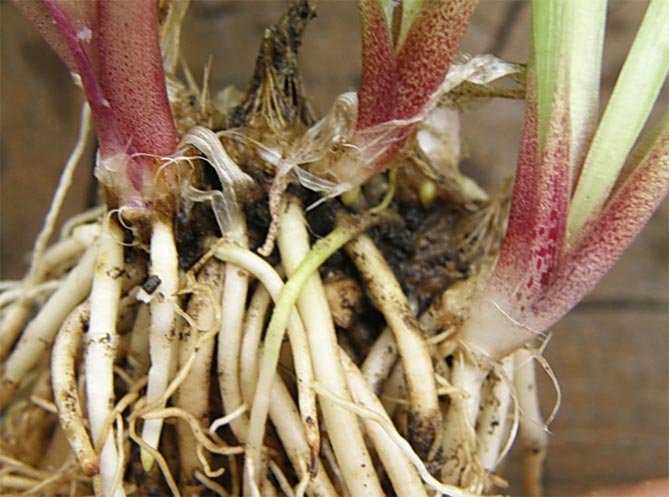

The root system is carefully examined and the place where the incision can occur is determined. The cut should be between the shoots so that each new plant has many roots.


The incision is made shallow to separate only the part connecting the plants and avoid unnecessary root pruning. The roots are neatly separated, thanks to which the plant forms one small wound.
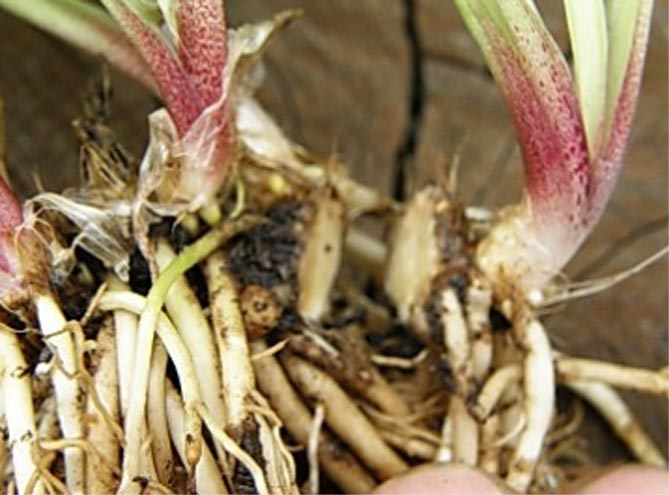

Every part of the plant must have a good root system. On such parcels, wounds heal quickly, seedlings grow well, develop quickly.


How do you divide a large plant?
The plant is dug in within a radius of 20 cm from the shoot farthest from the center of the shoot. With the help of a shovel, they get the entire root ball to the surface. The use of a pitchfork is recommended, but can be excavated with a shovel.
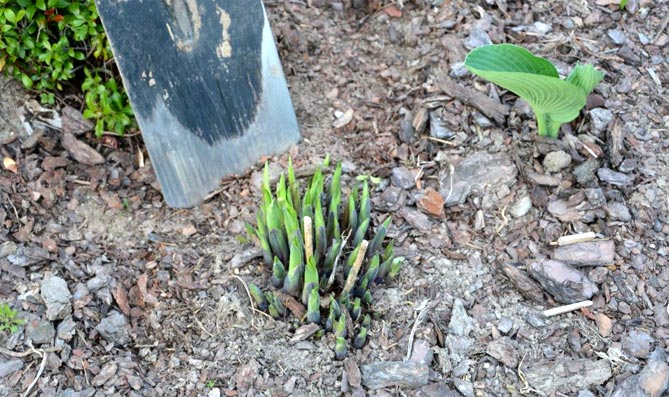

In an adult plant, the root ball will have to be cut with a shovel. The root system will recover more slowly.


Immediately after dividing, the seedlings are planted in the ground.


Seeds
Hosts can be propagated from seed, but then the characteristics of the variety may not be transferred, and it takes more time to get mature plants. Some garden varieties do not produce germinable seeds.
When the hostas reproduce, the seeds of plants growing in the garden should be harvested in the fall, when the seed bags dry out and begin to burst. Seeds are sown for seedlings in late autumn or early spring.


For sowing, it is important not to use ordinary garden soil, as there are many fungi in it, which, in conditions of high humidity and higher temperatures required for seed germination, will find ideal conditions for development. Either the garden soil needs to be heat treated, otherwise we will grow mold along with the seeds. The pots need to be thoroughly washed (disinfected) or bought new ones.
Hosta seeds are sown in pots or seedling boxes. They should be evenly distributed over the entire surface of the substrate, and covered with a thin layer of soil.
At the initial stage of plant growth (before the seeds germinate), the pots can stand in complete darkness, only high humidity and high temperature of the substrate are important.


Near crops, the air temperature should be 25-30 degrees, and the soil temperature 20-25 degrees Celsius.
After 2 weeks, the first shoots appear.
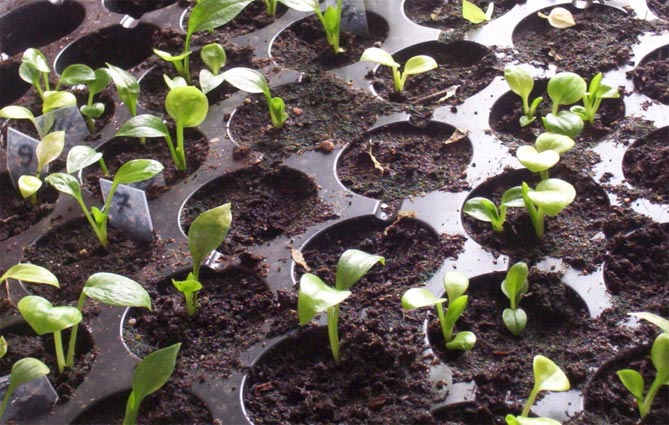

When the seedlings germinate, the darkening is finished. Seedlings are transplanted into new containers, placed on the windowsill. It is important to maintain high soil and air moisture.
Proper lighting of the seedlings is very important. Hosts do not need a mandatory blackout period - nights. Therefore, even 24-hour lighting will do. So you can accelerate the growth of seedlings (compared to unlit ones) for several months.
For lighting, you can use fluorescent lamps with a power of 30-60 watts. You can turn on the 7W LED lamp, which shines during the day and until late at night.
How to choose seedlings?
The host is planted in a flower garden with seedlings, which you can grow yourself, or you can buy ready-made young bushes.


If the root system is open: in this case, the roots themselves, as it were, do not yet exist, there is only a bud, which is rooted in the ground. Such a host will be able to bloom no earlier than three years. Seedlings are planted in the ground, in a small hole, sprinkled with earth.
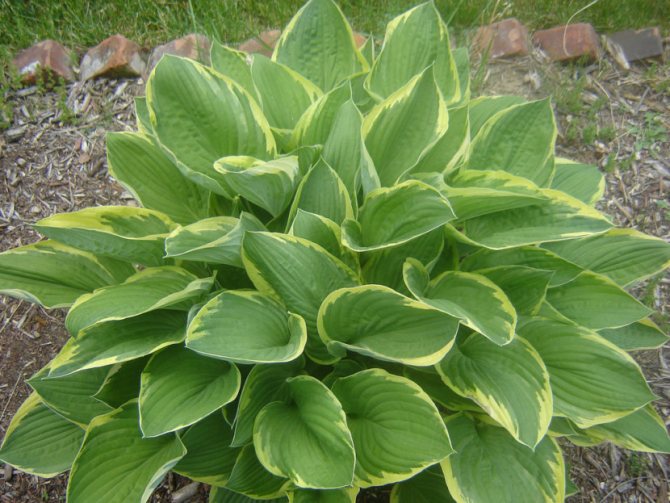

It is better for the host to buy in trusted places or large flower shops, it is desirable that the root system is closed with small leaves. Thus, in the fall you will have a young plant, quite ready for full development and flowering.
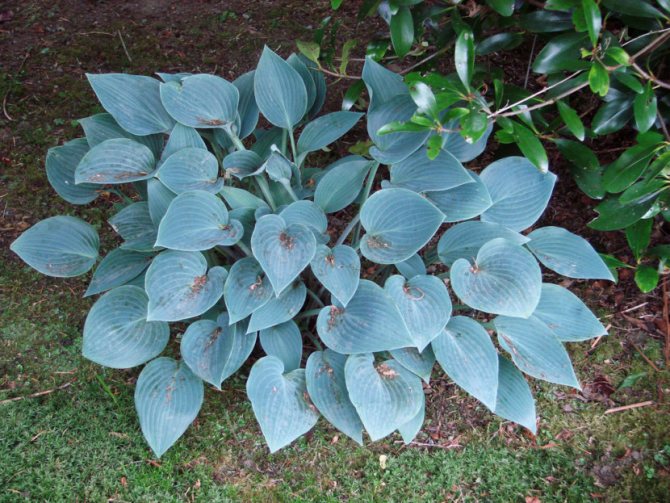

Before planting a flower, you must also check the integrity of the root, they must be dense, solid, white.
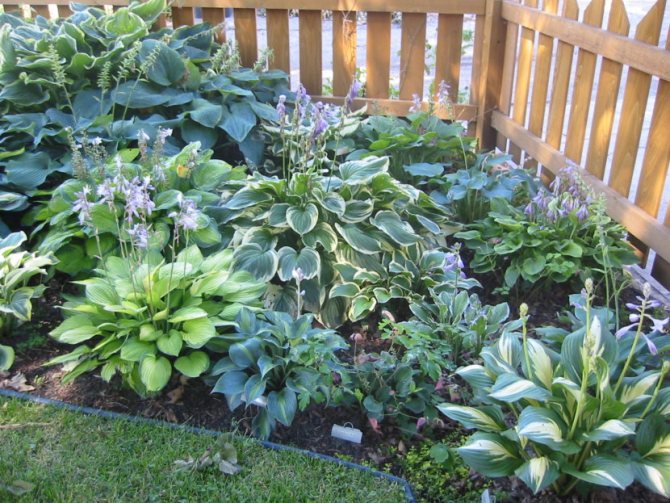

If the roots are slightly damaged, they should be cut off, however, such roots should not be taken; if there is a choice, it is better to buy a healthy ovary.
Things to Remember
- Seat selection... The best option for almost all hosta varieties is partial shade.
- Planting material... The most reliable division of the root system is considered. Seeds germinate for a long time and do not guarantee a quality result.
- Watering... It is advisable for the host to water at the root, especially for varieties with a wax coating of leaf plates.
- Landscape design... When buying, you need to take into account the size of this variety, otherwise a small seedling in a couple of years can close all nearby plants.
Gardeners reviews
B & C
We mulch large hosts with freshly cut grass from a lawn mower for 5 years, no weeds. Well, I liked it very much.
GALAS
I overexpose in the refrigerator or basement for many years, it happens from January. The only thing is that I cover the roots with slightly moist sphagnum. So I overexpose many roots.
Hosta border
The host is distinguished by the stability of the decor.Therefore, it is often planted on both sides along the paths and paths on the site. But do not expect that immediately after disembarkation, the effect of the invented design will be obtained. We'll have to wait until the plant gets the right size. For such a design, it is recommended to plant hosts of the same variety. So that the plant does not grow too much and looks miniature in the area of the path, it is necessary to use varieties up to 15 cm high. One of these is considered to be Blue Mouse Ears.
Combination and placement ideas
When choosing a host, you need to know the planting site and focus on the volume of the bush. Low-growing varieties are planted in rock gardens, rocky gardens, used as a border plant in the edging of flower beds, garden paths. Tall trees decorate lawns, combine with other plants. Mediums are ideal for decorative additions and for creating mono flower beds.
I offer a photo review of successful combinations and site decoration with hosts:
Flowerbed with hydrangea and petunia


Duet with Astilbe. Photo: postroim-


Shady corner with daylilies and irises. Photo: i.
mixborder with
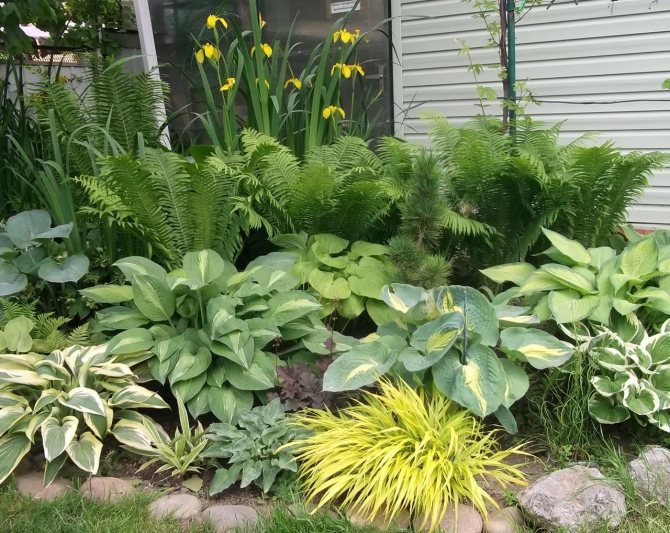

Mixborder with swamp iris and fern. Photo:
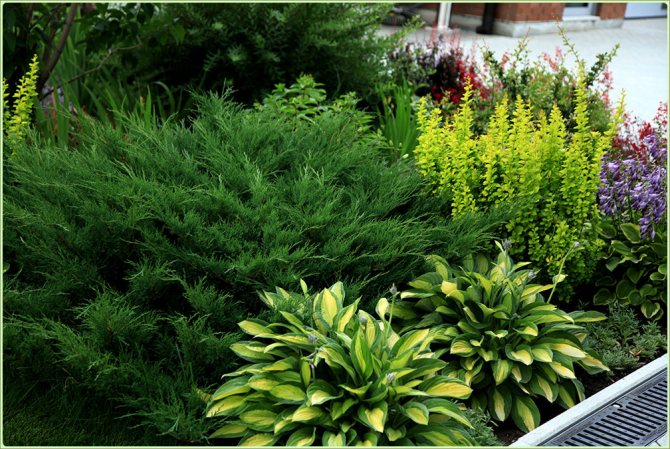

Juniper variant
Landing in open ground
It is recommended to understand in advance the peculiarities of transplanting seedlings into the garden.


Timing
It is necessary to transplant the host in early April, after the end of the frost. It is too late to plant them, so the deadline is mid-May.
Features of the requirements for lighting of various grades
All varieties thrive in shaded areas and therefore do not need to be planted in lighted areas.
Soil requirements
When choosing a site for planting, pay attention to the ground. It should be rich in mineral and organic components necessary for the growth of seedlings.
How to plant
To plant flower seedlings, you need to dig holes 6-8 centimeters deep on the site. Then hosta seedlings are placed in them, sprinkled with earth and poured with water.
Choosing a landing site
The host is simple and undemanding to care for. Variegated varieties are sufficient 3-4 hours of morning or evening light; monochromatic ones will not lose their beauty in more shaded places. Excess sun, and even more direct rays, on the contrary, can harm graceful bushes - this is important to consider when choosing a place for planting.
In one place, the host can spend up to 10 years without requiring a transplant. Loams, lightweight with peat, with a high content of organic fertilizers are considered optimal for it. On chernozems and sandy soils, which retain moisture worse, it grows more slowly and requires more frequent watering. At the same time, the hosta does not tolerate stagnant water and waterlogging, so they try not to plant it in lowlands, or drain the soil well.
Botanical portrait
The perennial has a compact rhizome, from which a dense rosette of basal leaves on long petioles grows.


Leaf blades are varied in size, structure, color - there are many variegated varieties and varieties, and also differ in shape - from narrow-lanceolate to broadly oval.
The height of the peduncles is different, in natural species it does not exceed 1 m, but in varietal plants there are flower-bearing stems about 130 cm high, and recently giants with a height of 185 cm have appeared along with an inflorescence.
The flowers are spectacular, bell-shaped or funnel-shaped, the corollas are 6-incised, usually of a delicate lilac or purple color, less often snow-white.
Inflorescence-raceme consists of 6-8 flowers, located one-sided on the peduncle. The fruit is a leathery three-ribbed box with flat black impeller seeds.
Diseases
Until recently, the culture was considered resistant to diseases, but it turned out that the plant can be affected by viruses from other plants (mosaic, ring spot, etc.). But the most common and dangerous of these is the HVX host virus, which is transmitted by the sap of an infected bush during procedures such as dividing or pruning.
Symptoms of the disease caused by the virus: the appearance of spots, transparent specks, lines or streaks, uneven foliage color, a change in its texture, compression. The disease covers the entire bush, causing foliage to fall and growth retardation. There is no cure, therefore, to prevent the spread of the virus at the first symptoms, it is necessary to dig up and burn the plant. The hosts can be put in the old place in three weeks.
Scientists, after conducting research, have established that a fairly large number of Siebold's host hybrids are resistant to the HVX viral disease.
Regional features
Growing hosts in different regions has certain characteristics.
Middle lane
The climatic conditions of the middle lane make it possible to grow flowers without additional shelters for the winter.


Ural and Siberia
In the Urals and Siberia, the climate is more severe, and therefore it is more difficult to grow flowers. The planted bushes will have to be mulched and covered with foil in the fall.
South of Russia
The southern climate is not suitable for hosts due to possible droughts in summer. Therefore, in the summer you will have to water the seedlings more often in order to maintain an optimal level of humidity.
Leningrad region
In the Leningrad region, the climate is ideal for growing hosts. The rainy summer encourages the growth and flowering of this plant.
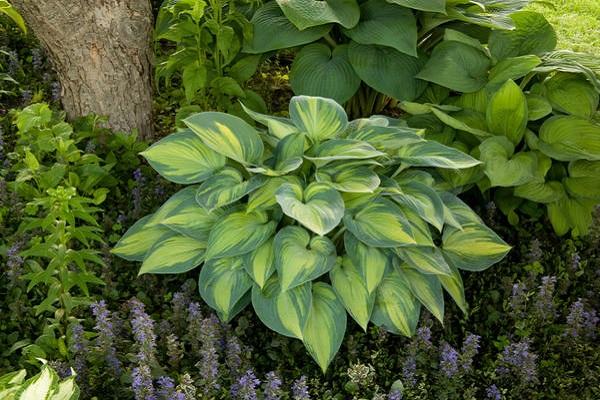

Landing in temporary containers at home
Plants are first grown in temporary pots or boxes.


The choice of planting material
In order for the planted seedlings to grow well, it is necessary to choose the right seed. The seedlings should be green and not dry. There should be no yellow spots on their foliage.
Rhizome preparation
Before planting, all the roots must be soaked in a manganese solution in order to disinfect them. For better rooting, they can be soaked in liquids with phytohormones and amino acids.
How to plant
Before planting the hosts, holes are made in the ground with a depth of 5-7 centimeters. Seedlings are carefully planted in them and the rhizome is sprinkled with soil.
Hosts after flowering
After the flowers fade, the peduncles must be removed. In September, the host begins to prepare for the dormant period. At the same time, flower growers are seating the host. First, half an hour before seating, you need to water well the area on which you have to work. Then the bushes are dug up and divided so that each part has one or more deciduous rosettes. They are seated at a distance of 25-35 cm from each other, burying them at the same depth at which the mother plant was. Host roots grow horizontally, so the pits should be wide.
After planting, the plants need to be watered abundantly for the first time. It is necessary to finish the process of dividing and planting the host before mid-September, so that the "newbies" have time to take root in a new place before the onset of the autumn cold. It will take four weeks for young hosts to take root. In spring, these delenki will begin to grow rather quickly: in two or three years they will become large adult plants.


Photo: Hosts in the garden after flowering
In the fall, work is carried out to insulate the site with the hosts on the eve of winter. For this, the site is mulched with leafy soil. This is especially necessary for hosts growing under trees: thanks to the mulch, the host will not have a lack of nutrients absorbed by the roots of the tree. Mulch, among other things, raises the level of the flower garden, and this improves soil drainage.
Wintering
In warm southern regions, you should not worry about wintering the host - the plant tolerates frosts perfectly, without getting wet or freezing even in extreme cold and thaw. But gardeners in the Urals, even in the Moscow region, should take care of planting in advance, mulching them with leaf humus.
You also need to cut off the peduncles after flowering, otherwise the bush will be loose. Whether or not to remove the leaves is controversial voaros. In warm regions, they are pruned almost to the root to protect the hosts from pests hiding in the greenery.In the northern regions, foliage is often left to serve as additional protection from frost, covering the roots after wilting.
Hosta care
How to care for a host in the garden
If the hosta grows in fertile soil, then it may not be fed for three to four years. The main top dressing for the host is humus and compost, which are applied in the fall in the form of mulch. It is undesirable to get carried away with mineral fertilizers, but if you decide that they are needed, sprinkle granular fertilizers around the host after rain or abundant watering. Plants are fed with liquid fertilizers (root and foliar) once every two weeks until mid-July, and then they stop, otherwise the host will continue to grow new leaves and will not have time to prepare for winter.
How to grow hyacinths - when to plant and how to care
The soil around the plants should be moist all the time, especially around young hosts, so it is very important to water the plants on time, and watering should be carried out in the early morning and at the root, and not on the leaves, which deteriorate from getting water on them. In addition, the stream of water should not be strong so that the soil does not compact, but, on the contrary, can be saturated with water as deeply as possible. The darkening of the tips of the hosta leaves is a signal that the plants do not have enough water.
- Escholzia: planting and care, growing from seeds
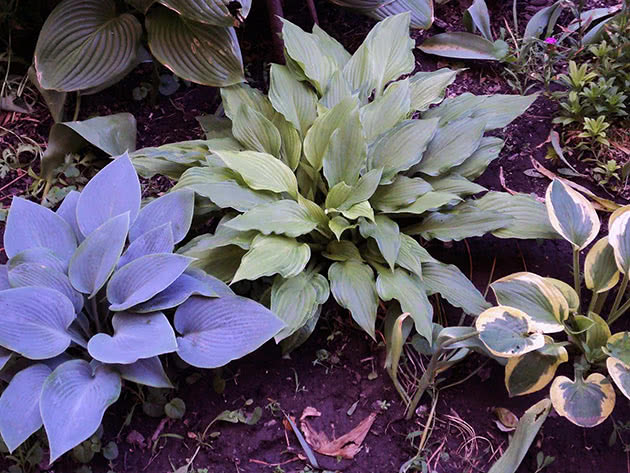

In the photo: Growing a host in the open field
If you are interested in making the hosta bush look neat, you will have to break out the young flower stalks, otherwise the hosta will "fall apart" after flowering. The host needs to loosen and weed only at first, when it grows, the weeds will no longer be afraid of it. After three to four years, the host needs to split up as it will grow a lot. Dig up the hosta and separate the young cuttings from the main root. This will not harm a healthy plant.
Diseases of hosts
Hosts are unpretentious plants, but Americans claim that the more host varieties in your collection, the higher the risk of getting an infected specimen. Sometimes hosts, weak or frostbitten by spring frosts, are affected by phyllosticosis, a fungal disease that manifests itself in the form of yellow-brown merging spots on the leaves. Sometimes the peduncles are affected by the fungus Phyllosticta aspidistrae Oud. Infected plants are removed and burned, and the soil in this place is disinfected.


In the photo: Hosta leaves turn yellow
Hosta suffers from gray rot (Botrys cinerea) and from sclerotinia (Sclerotinia). Rot affects the leaves of the hosta, fighting it with fungicides, which are based on folpet. Sclerotinia is a fungus, white cotton mold, detrimental to the root neck of the hosta. It is eliminated with dichlorane.
How to properly plant and care for a rhododendron
Pest hosts
The main plant pest is slugs. A sign that the hosta has attracted these garden pests is large holes in the leaves. Dealing with them is simple: place bowls of beer around the host, and a day later go and collect the slugs that have slipped down to drink beer.


In the photo: Slugs on the leaves of the hosta
In addition to slugs, stem nematodes are not indifferent to the host. Signs of their vital activity look like necrotic yellow spots spreading between leaf veins. A simple test will help to detect the appearance of nematodes: put finely chopped hosta leaves in a thin-walled glass, fill them with water for half an hour, and then look at the contents in the light. If there are nematodes, you will see the worms swimming in the water. It is impossible to fight nematodes, since chemicals will not destroy the eggs they have laid, and they will give new nematodes the next year. Plants will have to be exterminated within a radius of two meters from the affected specimen.
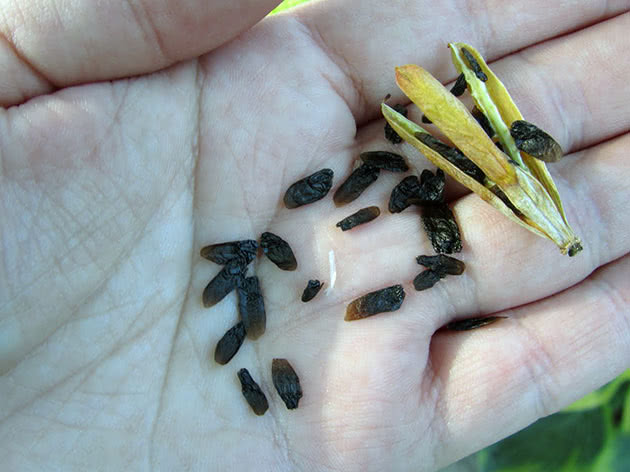

In the photo: Collecting hosta seeds after flowering
The danger for the hosta is represented by caterpillars, which, having appeared unexpectedly, can destroy the entire plant in just one night, as well as beetles and grasshoppers, after the invasion of which the leaves look like Swiss cheese. Only insecticides can save the host from insects.
Landing technology
To plant the hosta correctly, they begin to prepare the ground in the fall - they cover the area with a 10 cm layer of organic fertilizer and dug it onto the bayonet of a shovel. The optimal time for landing is considered to be the first - second decade of May, when the soil warms up enough and the threat of return frosts has passed.
In regions with mild winters, hostu can be planted in early September, so that the bushes have time to take root before the onset of frost. Some thermophilic and "capricious" varieties, as well as young hosts grown from seeds, are not planted in autumn.
Planting holes are made in a few days at a distance of 30 cm to 1 m, depending on the size of the variety. The depth should be such that the seedlings can be buried a few centimeters. Drainage, peat and some sand are placed on the bottom. Water abundantly immediately before planting.
The seedling is placed in a hole, the roots are gently straightened and covered with soil, lightly tamping. Water again. In order for the hosta to take root faster, the land around the bushes is mulched with sawdust or straw.
Host species and varieties widespread in culture
The genus Hosta of the Asparagus family (formerly Liliaceae) consists, according to The Plant List, of 23 species.
Some of them are already known only in culture, but do not occur in nature.
The varietal diversity is extremely numerous - various sources name from 600 to 1000 varieties and hybrids bred for horticultural floriculture.
The most popular species in culture:
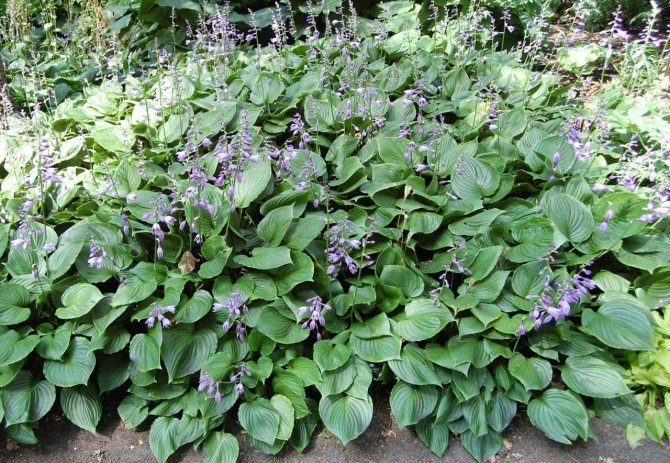

The swollen host (H. ventricosa) is a perennial from 30 to 50 cm high with broadly oval heart-shaped, pointed at the apex, dark emerald leaves reaching 25 cm in length. The peduncle is non-leafed, rises about 125 cm above the ground level, bears a loose one-sided inflorescence of violet-blue drooping corollas up to 5 cm long, opening in July and August.


Hosta white-bordered (H. albo-marginata) is a low plant up to 25-30 cm in height with thin leaf blades of a broad-lanceolate form, growing in length no more than 15 cm. Their color is dark green, a narrow white edging stretches along the edge. The peduncle is only 30 cm tall, on its crown in July-August an inflorescence-cluster of funnel-shaped lilac-purple, sometimes white flowers is formed.


Hosta Siebold (H. sieboldiana) is a perennial herb 25-30 cm high with dense gray leaves covered with a waxy layer. Leaf blades are ovoid, about 35 cm long. The peduncle grows up to half a meter, sometimes up to 80 cm, as a rule, it has one medium-sized leaf. A dense, numerous short inflorescence of light purple or lilac-purple funnel-shaped flowers 5-6 cm long is formed in July-August. Hosta wavy (H. undulata) - the height of a small perennial 25-30 cm. Leaves in a basal rosette are elongated-ovoid with strongly wavy edges. The leaf blades are colored white in the center, and the edges are green. Sometimes the colors are interspersed with greenish and white spots. The peduncle, reaching 80 cm in height, has several leaves. In a loose inflorescence 6-8 bell-funnel-shaped pale purple flowers about 5 cm long.
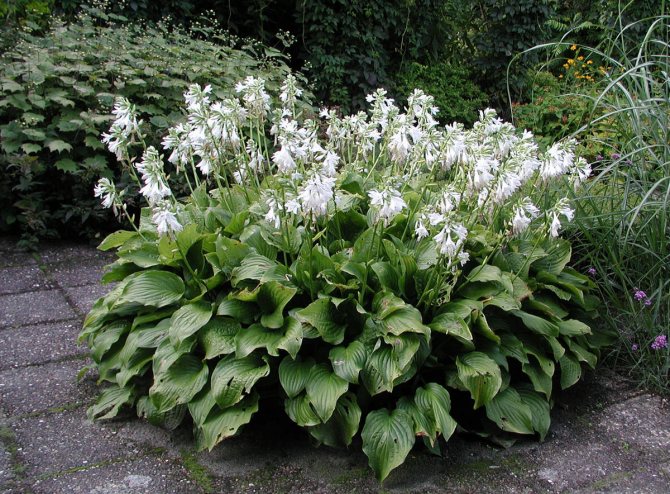

Hosta plantain (H. plantaginea) - grows up to 30-50 cm. The foliage is large, shiny, bright emerald in color. The leaf blades are thin, round-ovoid. 1-2 leaves are also formed on the peduncle. The inflorescence is formed at the end of summer. Large fragrant snow-white flowers with a tubular corolla are grouped into a dense brush.
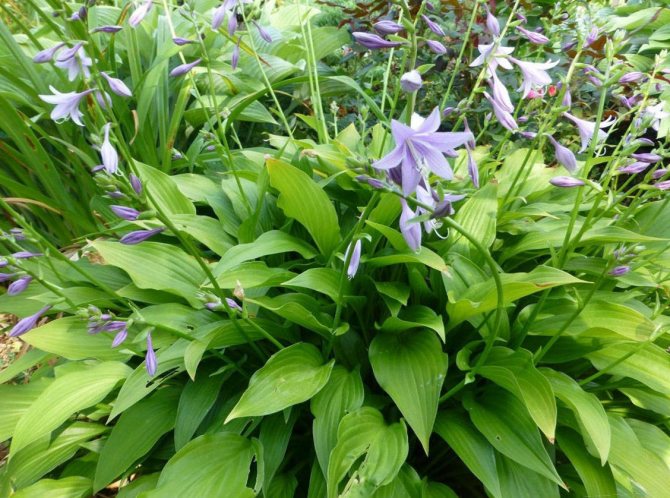

Hosta lanceolate (N. lancifolia) - lush rosettes reach a height of 30-40 cm. Leaf blades are lanceolate, with a bright emerald sheen, marked with a cherry-brown spot at the base. The peduncle grows about 30-50 cm tall, bears a loose cluster of funnel-shaped purple flowers, fragrant from mid-August to the second decade of October.
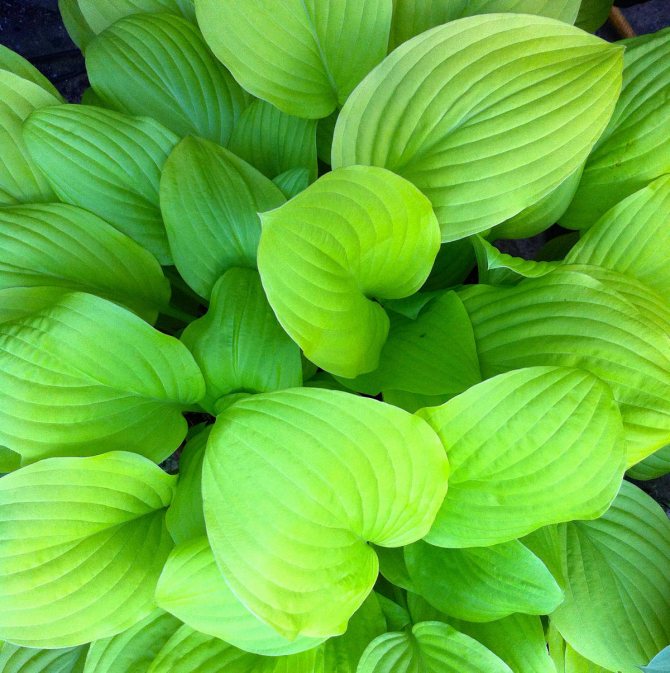

Hosta Fortunei (H. fortunei) - very similar to the host of Siebold, but smaller in size and with a less pronounced waxy layer. The foliage is cordate, covered with bloom on the underside. The peduncle grows up to half a meter up.A compact and multi-flowered inflorescence with purple funnel-shaped flowers 4-6 cm long forms at its top in August.


Curly host (H. crispula) - dense rosettes form dense sod. The leaf blades are ovoid, deep green, glossy below, matte above, with a wide white border and strongly wavy along the edge. Funnel-shaped purple flowers form a one-sided loose brush in late August - early September.
The best varieties:
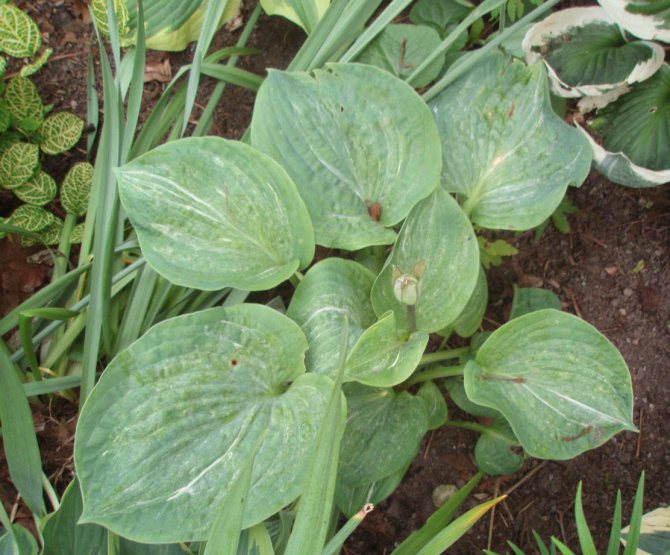

With spotted leaves
plants are especially beautiful, in the color of the leaves of which 3-4 shades are combined:
- Helios and Color Parade - with green-yellow-white leaves;
- Galaxy - with dark emerald, light green and yellow leaves;
- Revolution, Ghost Spirit and Clifford's Comet - with green streaks on the white center of the leaf blades;
- White Wall Tire - with emerald strokes over the white background of the entire leaf;
- Spirit Milk and Korean Snow - with white strokes on the green surface of the leaf blades.
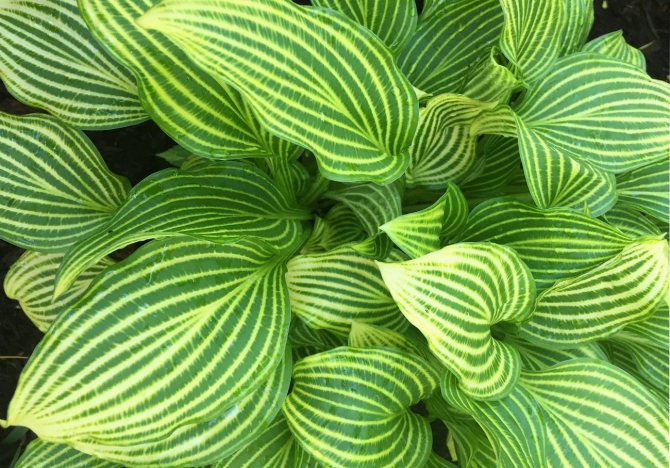

With longitudinal lines - Amime Tachi Giboshi and Mito-no-Nana.
Single color hosts:
Yellow-leaved - Fried Bananas with large smoky leaves and Sum and Substans with large shiny leaves.
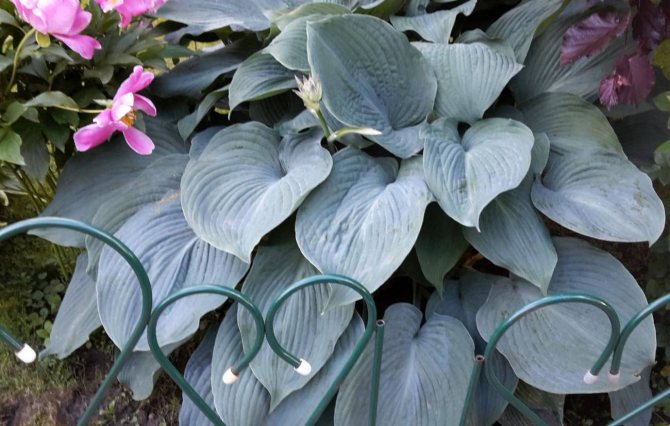

With blue foliage:
- Blue Angel with flat blades;
- Blue Mammouth with unusual waffle leaves;
- Blue Arrow with oblong pointed leaves;
- Blue Piecrust with wavy leaf blades;
- Blue Moon with heart-shaped leaves;
- Blue Ice is a miniature variety with almost round foliage.
With very dark green leaves - Black Beaty, Black Hills, Kiwi Black Magic.
With a pattern on the leaves:
Edged around the edge:
- Stained Glass with yellow foliage and a green stripe around the perimeter of the leaf blade;
- Fire and Ice with white leaves and a green edge;
- June-close-up with yellow background and blue border;
- Trances Willams - with blue leaves bordered with a yellow stripe;
- Sogae with a green base color of the leaf blade and a yellow or cream edge;
- Patriot with green foliage and white outline and others.
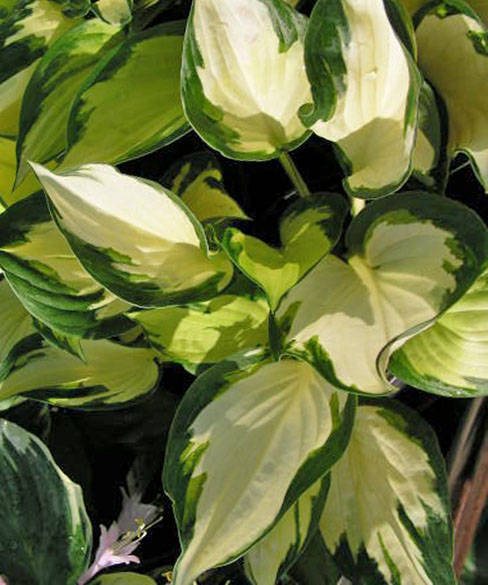

The pattern in the center of the leaf is Morning Light with yellow flame on the green surface of the leaves, Mutant Ninja with a narrow white stripe on a bright emerald background along the central vein.
Fertilizing and feeding hosts
How the plants in your garden look like depends on the care, including the intensity of fertilization. The hosta looks more decorative, which is fed 3 times per season:
- during the growth period;
- during flowering;
- after him.
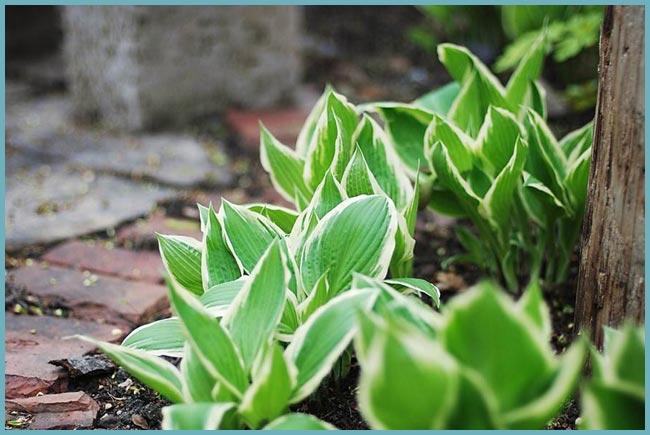

The host needs feeding several times a season.
For these purposes, fertilizers with nitrogen, potassium, phosphorus are most often used. Compost and humus are also useful for hosts. It is better to bring them in in the fall. Organic fertilizers are preferable to mineral fertilizers. The "golden rule" of leaving is not to overdo it. Too frequent or abundant feeding can provoke a burn.
Even an unpretentious perennial requires care.
Caring for hosts assumes that you are in control of two important things: high humus content and soil moisture.
The first 4 years after planting, fertilizer can be omitted. It is enough to mulch the soil around it once a year. It is also permissible to use liquid mineral fertilizers once every 14 days in the first half of summer (for poor land with a low content of nutrients).
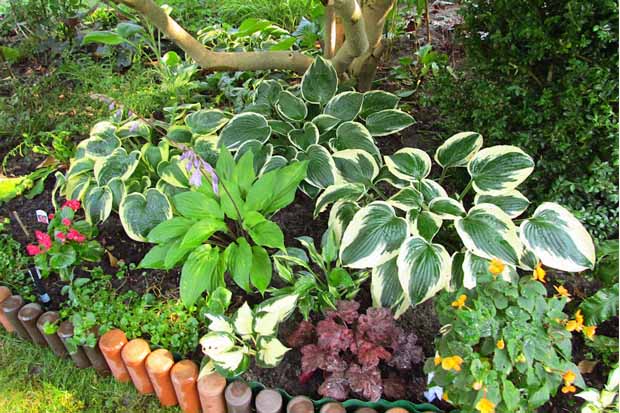

The soil around the bush must be constantly moistened. Water it in the morning, avoid getting water on the leaves. Make sure that the flower is not affected by diseases and pests. If necessary, use special preparations, or remove the diseased plant from the site.
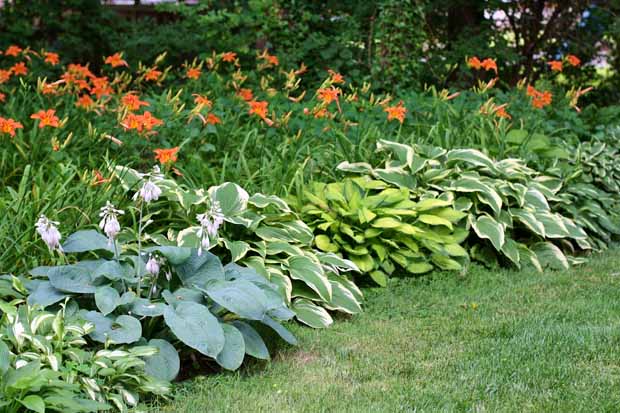

If you notice that the edges of the leaves have darkened, increase the watering. Moderate soil moisture is essential for caring for these hosts.
The peculiarity of the plant is that after flowering, the rosette loses its shape. To prevent this from happening, some gardeners cut off the peduncles at the stage of formation. 5 years after planting, cuttings can be separated from the root and transplanted to another place.
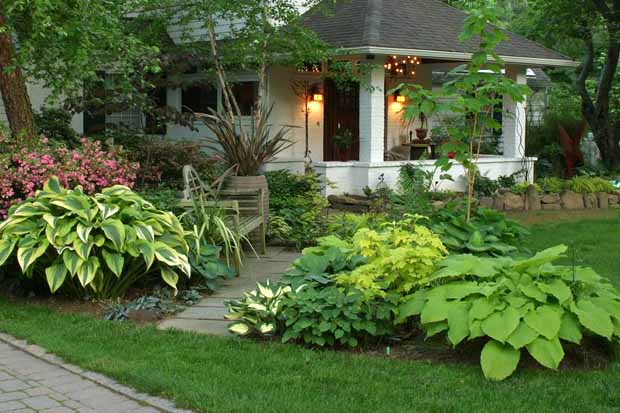

September is the time to prepare for rest. If the perennial has preserved peduncles, remove them. During this period, you can start dividing the bush.



